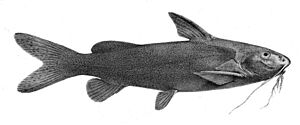Wahrindi facts for kids
Quick facts for kids Wahrindi |
|
|---|---|
 |
|
| Conservation status | |
| Scientific classification | |
| Synonyms | |
|
Synodontis gambiensis Günther, 1864 |
The Synodontis schall, also known as the Wahrindi, is a special kind of catfish that often swims upside down! You can find this fish all over northern Africa. It belongs to the largest group of upside-down catfish. These fish can grow quite big, up to about 49.0 centimetres (19.3 in) long.
Contents
Where They Live
The Synodontis schall catfish lives in Africa. You'll mostly find them in a place called Lake Nubia. They are super good at adapting to new places and different kinds of food. This helps them survive much better than other fish in the same family!
What They Look Like
The Synodontis schall has a tough, shield-like body. It also has strong, bony spines on its side fins (called pectoral fins) and its back fin (called the dorsal fin).
Scientists have noticed that these fish can look a bit different depending on where they live. For example, some Synodontis schall have more teeth and special filters called gill rakers in their mouths. This might mean they are changing from eating mostly plants to eating more meat!
How They Make Sounds
The Synodontis schall has a special part inside its body called a swim bladder. It looks whitish and has very thick, stretchy walls. The back part of this bladder is even thicker than the front.
This swim bladder is connected to the fish's backbone and muscles. When the muscles squeeze and relax the swim bladder, it makes a deep grunting sound! You can hear this sound up to five meters away. The sound starts strong and then quickly fades. These fish make sounds when they are scared, hurt, feeling aggressive, or when they are spawning (laying eggs).
What They Eat
The Synodontis schall eats a mix of different things, which means they are omnivores. Their main foods are water plants (called macrophytes) and algae. But they also eat fish scales, fish eggs, insect larvae, and small snails or clams (called molluscs).
Reproduction
We don't know a lot about how Synodontis schall reproduce. Things like their environment and their bodies can affect when and how they mature. They usually lay their eggs between July and October. They tend to lay more eggs when there's a lot of rain.
Relationship with Humans
The Synodontis schall is an important fish in Benin, a country in Africa. Fishermen often catch these fish in their nets. Because the fish have strong spines, fishermen sometimes have to break them to get the fish out of their nets. People catch Synodontis schall for food or to trade, as they are considered valuable fish.


